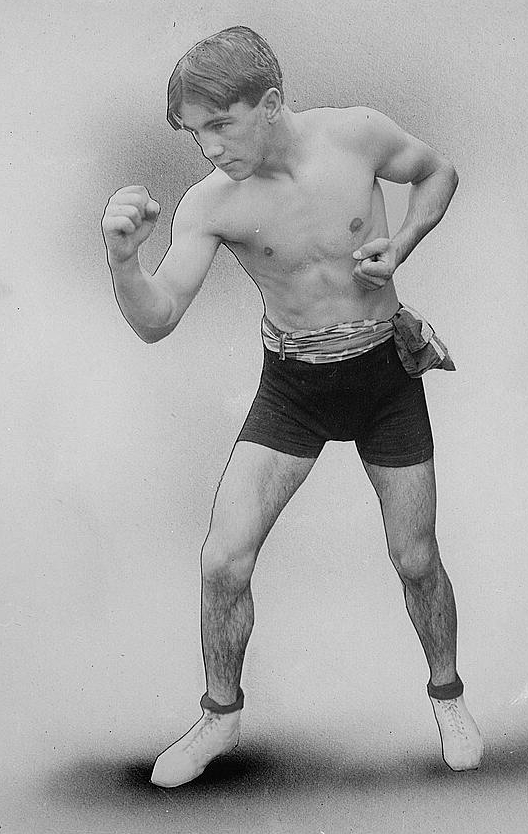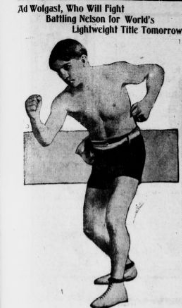Ad Wolgast Wins Lightweight Title
On Tuesday, February 22, 1910, Ad Wolgast challenged World Lightweight Boxing Champion Battling Nelson for Nelson’s title at Richmond Arena in Point Richmond, California. The 28-year-old Nelson won the title by knocking out the great Joe Gans in 1908.
Boxing experts did not expect Wolgast to defeat Nelson even though Wolgast held a newspaper decision over Nelson in 1909. Pundits felt Nelson was too experienced for the 22-year-old Wolgast in fight to the finish. Wolgast had a surprise for the experts.

Ad Wolgast, World Lightweight Boxing Champion around 1912 (Public Domain)
Eddie Smith refereed the bout fought under the old prize ring rules. Ad Wolgast carried out a perfect game plan to fight his older opponent, who displayed more durability than boxing skills. Wolgast slipped Nelson’s heavier punches, fired back with multiple combinations, and beat Nelson’s face to a pulp.
Nelson only had one chance to win the fight when he staggered Wolgast in the twenty-second round. Wolgast regained his bearings and Nelson’s chance evaporated. Wolgast continued his relentless combinations until referee Eddie Smith mercifully stepped in during the fortieth round protecting Nelson from further punishment.

Ad Wolgast at the time he won the World Lightweight Boxing Championship (Public Domain)
Fortunately, camera operators filmed the bout in 1910, a frequent practice in boxing and wrestling at the time. Preservationists saved about ten minutes of the forty-round fight. Wolgast is the shorter fighter in the light-colored trunks. In the beginning of the film, Wolgast is often on the left of the screen.
Wolgast defended his title for two years before losing it to Willie Ritchie in 1912. In the years that followed, Wolgast displayed odd behavior, eventually being committed to a Wisconsin asylum in 1917. Doctors believed Wolgast suffered a nervous breakdown due to the strain of his prolific boxing schedule of ten or more fights a year and suddenly finding himself extremely wealthy due to his ring exploits.
The Wisconsin Court appointed Wolgast’s wife as guardian. Wolgast escaped the hospital and lived in a California forest, where forest rangers found him in December 1918. A California Court reexamined Wolgast, who told the court Mrs. Wolgast used the commitment process to hold Ad Wolgast prisoner and control their finances.
While the California court did find Ad Wolgast competent to handle his own affairs, the examining doctors testified that the Wisconsin Court confined Ad Wolgast on solid medical evidence. Jess Willard, World Heavyweight Boxing Champion, was so concerned about his friend’s behavior that Willard convinced Ad Wolgast to check into the hospital. Mrs. Wolgast started the commitment process after Willard shared his concerns with her.
In 1927, a California Court again committed Wolgast due to dangerous psychosis. The physician, who examined Wolgast, stated that while Wolgast displayed amazing physical development, the constant punches to the head during his boxing career incapacitated Wolgast mentally.
Even though Wolgast had not fought since 1920, Wolgast believed he was training for a World Lightweight Title fight. One hundred forty-four fights over a fourteen year career is too much physical punishment for any human being as Ad Wolgast’s case tragically proved.
The court confined Wolgast to Camarillo State Hospital in Camarillo, California, where Wolgast died on April 15, 1955. Wolgast lost his eyesight in 1951 but prior to losing his vision Wolgast shadow boxed and jumped rope every day training for a World Lightweight Title rematch. Wolgast was 67 years old. He spent almost thirty years at the hospital.
You can leave a comment or ask a question about this or any post on my Facebook page or Twitter profile.
Sources: Salt Lake Telegram (Salt Lake City, Utah), February 23, 1910, p. 9, The Los Angeles Times (Los Angeles, California), December 21, 1918, p. 9 and Pasadena Independent (Pasadena, California), April 18, 1955, p. 41
Pin It
